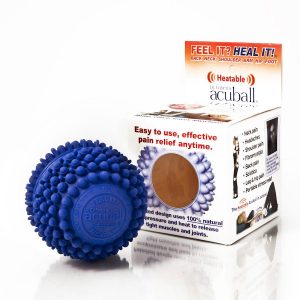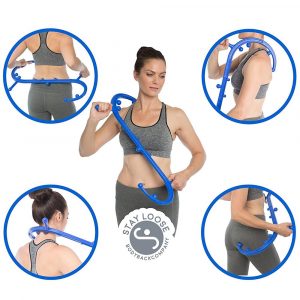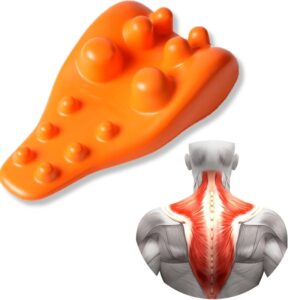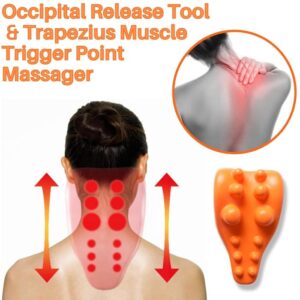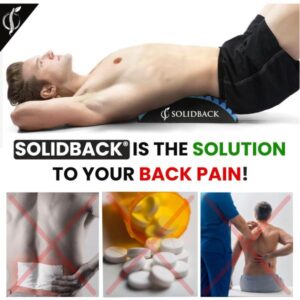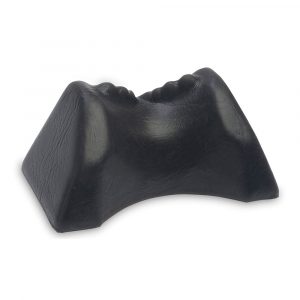Muscle Therapy For Treating Your Own Neck & Back
Many instances of neck and back pain can be related to problems with muscles. Typical areas of back strain and neck strain can range from sore, tired or overworked muscles, to tears in muscles which can cause significant pain. Using both electric and manual massagers can help treat these condition from a superficial massage, to deep muscle therapy and trigger points.
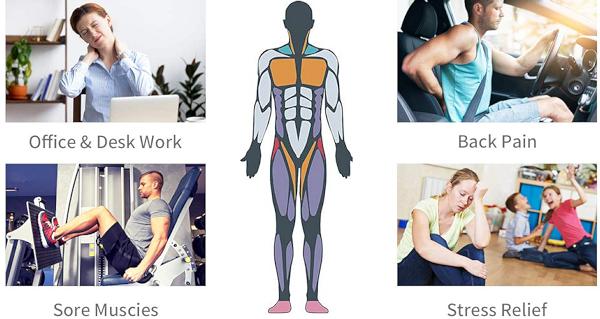
Sore or stiff muscles can interfere with daily living activities along with sports performance. At work, a frequent issue is muscle soreness, pain and tenderness, which often affects workers that are frequently using one-sided and repetitive movements.
Therapy That Allows You To Control The Massage
Most of the products are ones you use yourself or require your active participation. This allows precise control of where, how much pressure and how long massage is applied. They make it easy to get at difficult to reach areas involved with neck strain, shoulder strain, back strain, or almost anywhere muscles can hurt.
Benefits of Muscle Therapy
Muscle therapy can help to relax sore muscles. When muscles are overworked, they can become tense and lack proper oxygen and nutrient supply. It can help increase the blood circulation as well as flow of nutrients, easing pain and promoting healing. There are many tools you can use at home effectively, including ultrasound.
Helping To Heal With Muscle Therapy
If you have injured a muscle, depending on the severity, massage should not be the first method of choice. A strain is a tear and, like tearing when you cut your finger, there can be bleeding, swelling and pain. This needs to calm down and heal. Again, depending on the severity, perhaps a few days. Severe strains may require surgery, however, for the basic muscle strain, a day or two using ice and perhaps an over the counter anti-inflammatory should suffice.
Using muscle massagers can help with the healing when the bleeding stops. Just as a cut needs to form a scar to heal, muscles need to form a scar to heal also. The problem is scar tissue is not as resilient as normal muscle tissue. Therapy massagers can help by forming a better scar tissue that will allow the muscle to function optimally. Using a massage device to place pressure along the muscle fibers will help the scar tissue form along the muscle lines, producing a stronger, more flexible scar. Thus helping to minimize chronic pain and maximize function, while reducing the chance of re-injury.
Trigger Points
Another use is to treat areas of muscle pain and dysfunction, often called trigger points. These trigger points can be active and cause pain in the area of the muscle as well as pain that is referred along a certain pathway. A muscle therapy massager allows the use of gravity and/or leverage to apply a deep pressure type of massage that can help treat these areas. A trigger point that is not active can still cause a muscle to not function properly. It can help to locate and then treat these areas using a held compression force that is somewhat uncomfortable, but not too painful. This method is called ischemic compression.
Trigger points can develop from injury, overuse and/or poor posture. Typical massage is applied to a specific area using compression for a short period. There are devices which allow you to control this pressure as well as monitor the progress.
- A 2021 review in Cureus indicates trigger points are hypersensitive taut bands that when triggered can produce pain, numbness, and tingling. Underlying causes (mechanical, nutritional, and psychological) participate in the cause, activatiion and intensifying pain. Chronic pain and psychological distress often coexist, and social and psychological factors have been found to worsen quality of life and perpetuate existing pain.
Exercise, posture correction, and a vitamin balance, especially in the Vitamin B complex, appear to prevent trigger point activation. Mechanical factors like poor posture and abnormal joint forces the musculoskeletal system to work in a compensatory way, and overuse syndromes seem to be the leading causes of activation of the trigger points. Nutritional deficiencies and, in particular vitamins B1, B6, B12, and folic acid, metabolic disorders, including hypothyroidism, obesity, hypoglycemia, and hyperuricemia as well as sleep deprivation, chronic infections, and arthritis, can also activate trigger points. Additionally, trigger points activate in organic diseases and hormonal disorders, such as menopause and dysmenorrhea.
Psychological factors can contribute to the perpetuation of myofascial trigger points and chronic pain, mainly hopelessness, depression, anxiety, and stress. Chronic musculoskeletal pain is associated with psychological distress and negative emotions. The significant effect of psychological factors on the activation of trigger points indicates a close relationship with the biopsychosocial model.
- A 2021 study in the Journal of Family Medicine and Primary Care found manual trigger point release in the upper trapezius muscle showed a significant decrease in pain intensity and increase in cervical range of motion and this was more effective than positional release therapy in computer users with neck pain.
Joint Problems
Massagers like the neck or back massager use an electric/battery power source to apply massage. This allows passive mobilization of the joints, helping to lubricate the joints and restore smooth motion. It will also help to massage the muscles, but can concentrate on restoring joint function through motion and increased nutrition. Similarly, using non-powered massagers can also help to mobilize the joints. This can be done for short periods, frequently, helping to treat hard to reach areas with ease.
Headaches
Headaches often accompany neck pain. This is usually due to the muscles at the base of the skull, called the occiput. This connects the muscles of the upper part of the neck to the base of the skull. These muscles often become stiff from poor posture or sleeping on a non supportive pillow, including stress and tension. Trigger points in this area can cause pain to radiate into the head. A method often used by therapists to help relax these muscles is called occipital release, and there are muscle therapy massagers that specialize in performing this type of therapy. The massage is used by lying on the massager and letting gravity do the work, however, doing some simple motions like rotating the head or doing the basic from of the neck exercises, the nodding motion, can help bring more rapid relief.
Tendonitis
Repeated work tasks can not only affect the muscle, but can cause tendon problems. Tendons are muscle attachments to bone. Tendonitis, inflammation of the tendons can happen anywhere there are muscles, but is common in the elbow area or the wrist extensors. A common form of therapy is called cross friction massage. This, unlike massaging along the lines of muscle fibers, actually massages across the tendons. This can be painful and is not done for long periods, however, it can help with tendonitis. Ice is usually applied after to control inflammation, but tendons can respond to this type of therapy.
Fascia
Fascia surrounds the muscles (myofascia) and is a continuous fibrous tissue that runs throughout your body. It is densely interwoven and connected to every muscle, nerve, blood vessels, bone and internal organs as well. Through injury, the fascia may form fibrous scars that can adhere to nerves. This can make movement very painful and upset the balance of the musculoskeletal system. Myofascial therapy helps to release entrapped nerves, so they may move freely; restoring motion and reducing pain, thereby increasing function.
While these techniques are best served by professionals, you may find a very specific area of particular pain. Treating the area by moving the muscle through applied pressure can help release the tissues. For more on the physiology of this technique, please see the neck injury page.
- A 2021 study in the Journal of Manipulative and Physiological Therapeutics showed a single application of myofacial release to the upper trapezius produced a decrease in neck pain on the side treated as well as the opposite side and was effective as dry needling.
- A 2019 study in the Journal of Sports Rehabilitation showed that self myofascial release with movement is effective for shoulder range of motion and muscle length, and may assist with rounded shoulder posture.
These tools are great for self myofascial release. An example would be the levator scapula, a muscle often involved with neck and shoulder pain, placing pressure at the top of the neck and pulling down towards the shoulder in line with the muscle, while bending the neck to the opposite side. Very effective and this can be done with just about any muscle and the muscle massager, cane tool and deep tissue blocks are great ergonomic tools for this.
- In a 2020 Clinical Biomechanics study it was found that in patients with chronic back pain, the lumbar myofascia showed a decrease in elasticity and this was observed more in females. There was also a correlation between being right handed and right sided lumbar myofascial stiffness.
The fascia is intimately associated with muscles and the various complications that arise are often termed myofascial pain syndromes.
- A 2020 study in the International Journal of Psychiatry in Clinical Practice found those with myofascial pain syndromes had significant higher affective temperament characteristics of depression, cyclothymia (emotional ups and downs), and anxiety than a healthy control group.
- A 2021 study in the journal Morphologie found that the fascia in the thoracic-lumbar spine increased in thickness and nerve fibers as you go down the spine with the greatest thickness and number of nerve fibers in the sacral area.
- A 2021 study in Clinical Biomechanics found myofascial release has immediate effects on neuromechanical characteristics patients with low back pain. There was a significant increase for velocity of contraction in lumbar erector spinae as indicated by tensiomyography.
- A 2021 study in Clinical Biomechanics found 4 sessions of myofascial release contributed to the normalization of the flexion-relaxation response, and also showed a significant reduction in pain and disability in patients with non-specific chronic back pain.
- A 2022 Review in Clinical Anatomy indicates Chronic neck pain is often associated with a number of symptoms including head and neck pain and eye movement disorders. The deep cervical fascia of the neck, the epicranial aponeurosis of the head, and the fascial sheath of eyeball form the proximal myofascial chain and therapy may help manage painful head and neck disorders.
- A 2022 study in Clinical Anatomy indicates the deep fascia in the neck and back is a three dimensional continuum of connective tissue surrounding the bones, muscles, nerves and blood vessels. Pathological fascia is displays increased tissue stiffness and altered cellular activity. There are an increased density and sensitization of nerve fibers and markers of inflammation.
Acupressure
This is an ancient healing art using light pressure on numerous healing points throughout the body. These points are thought to stimulate your body’s natural healing abilities. This is a treatment is very good for stress related problems and can be used alone or along with other therapy methods.
Reflexology
This is based on the principle that your body is interconnected via your nervous system. It is thought that stimulating nerve endings in your feet and hands can help treat ailments problems throughout the body. Reflexive points may relate to acupoints and can be treated similarly. These last two methods are the least aggressive of the treatments. This allows everyone to benefit from massagers that aid you in self treatment and awareness.
Muscle Therapy Effectiveness
Muscle soreness can negatively interfere with daily and work activities as well as sports performance. This soreness can result from inflammation caused by micro‐tears in muscle fibers during repetitive activity and/or contractions.
There are many of these devices and some of the designs are simply ingenious. Some of them are very useful in that they can do massage on just about any muscle, making them very versatile, lightweight and easy to use. The popularity shows that using one can really help. Research also indicates some of these massagers can help alleviate pain and dysfunction.
- A 2014 study in the International Journal of Sports Physical Therapy, indicates a muscle therapy massage devices reduce pain and soreness of an affected muscle. The authors indicate 10 minutes of massage tool application has an acute soreness reducing effect with higher tolerance to pressure in the affected muscle.
- A 2018 study in the journal Sports Medicine – Open found a tool assisted self help device (muscle-fascia tool) promoted meaningful changes in parameters related to range of motion, mechanical tissue properties (stiffness, elasticity), and pain reduction.
- A 2019 study in the Journal of Bodywork & Movement Therapies indicated myofascial release helps restore tissue extensibility and is useful in many conditions like low back pain, ankle injuries, fibromyalgia, and headaches. The study indicates that this type of muscle therapy has to biomechanical and systemic effects reaching beyond just the local area of treatment. It reduces pain locally and systemically, while increasing range of motion.
- A 2019 study in the Journal of Exercise Rehabilitation studied the effects of massage consisting of connective tissue manipulation: muscles, tendons, fascia, and ligaments. The group receiving the manipulation showed significant improvements in improved pain, mobility, and well being in patients suffering with chronic low back pain compared with those receiving physiotherapy alone or sham massage.
- A 2019 study in Applied Ergonomics found a short 8 minute period of tissue manipulation with a massager was more effective at reducing significant increases in back stiffness than a controlled standing task break for workers sitting for 4 and a half hours. The authors concluded, “This study indicates that short-duration tissue manipulation can be an effective active break between prolonged sitting periods to prevent musculoskeletal issues, such as musculoskeletal discomfort and back pain.”
- A 2019 study in the Journal of Bodywork and Movement Therapies indicated an integrated neuromuscular inhibition technique program (soft tissue mobilization techniques) had a positive effect on neck muscle strength and endurance in individuals with chronic mechanical neck pain. The authors indicated that incorporation of muscle therapy techniques with exercise provided better results than exercise alone.
- A 2019 study in the Journal of Back & Musculoskeletal Rehabilitation indicates most of the mechanical massage techniques imitate manual massage. Products like the neck massager and back massager function in this manner. The authors noted a significant difference between mechanical massage and rest on serum cortisol and creatine kinase for exercise-induced muscle fatigue. The authors conclude mechanical massage may reduce stress and muscle damage for the athlete after training or competition.
- A 2020 study in Physiotherapy Theory & Practice found a self-administered program of 4 weeks focusing on muscle therapy was effective in reducing active trigger points. It was noted that pain severity and aspects of functionality also significantly improved.
- A 2020 study in the Journal of Manual and Manipulative Therapy found treating active trigger points manually improved pain and function in the short to medium term for neck and upper back pain.
- A 2023 study in Somatosensory & Motor Research indicates deep tissue massage is effective on neck range of motion, disability, pain, and quality of life. It is a safe as well as inexpensive treatment method that can be for myofascial pain syndrome.








